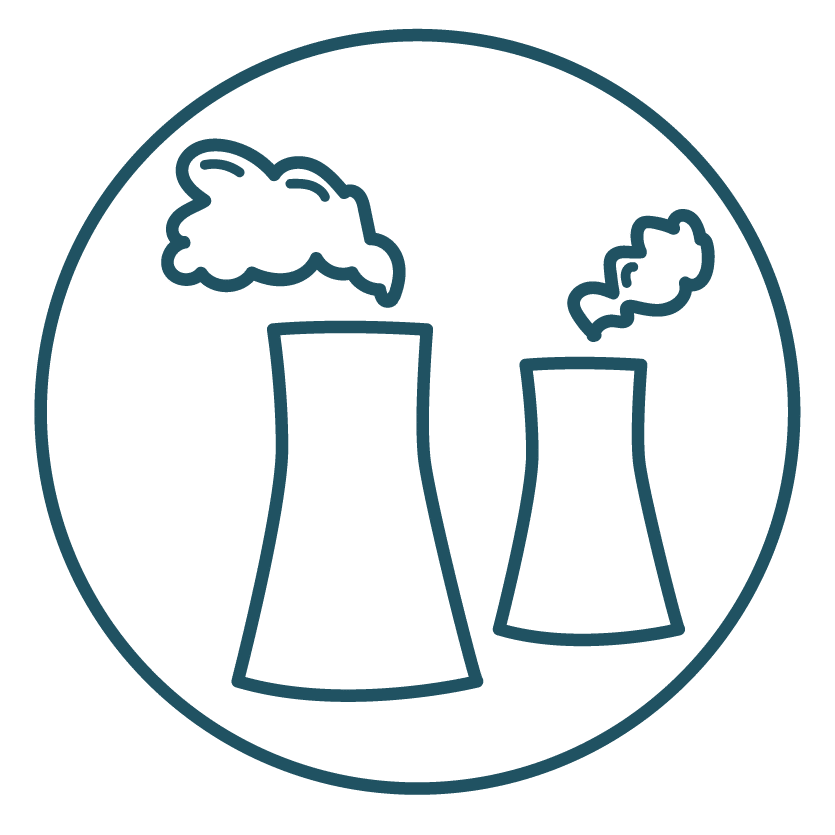Power Plants and Utility
Workers in the power plant and utility industry handle a range of known inhalation and contact risks that may lead to occupational cancer and disease.

Occupational Diseases in the Power Plant
and Utility Industry
The United States is the second-largest consumer of energy in the world, exhausting about 3.9 trillion kilowatt-hours (kWh) annually. The majority of power plant and utility industry facilities that provide this energy are fossil-fuel-burning powerhouses and nuclear energy plants. Moreover, the materials used and/or produced by power plants (like coal or electromagnetic fields) are public health and environmental concerns. For workers in the power plant and utility industry, repeated exposure to these carcinogens can lead to long-term health problems like brain or lung cancer.
In the U.S., there are 450 coal-powered power plants responsible for about 37 percent of the country’s electricity. The generation of energy at these facilities releases 84 different hazardous air pollutants (HAPs) into the air. Too, utility-related workers at coal powerhouses regularly inhale small particles of coal ash during plant operations, transportation, and, disposal. Overall, the materials used to produce energy (that simultaneously expose workers to occupational lung diseases) include:
- Biogenic municipal solid waste
- Coal
- Landfill gas
- Natural gas
- Petroleum coke and liquids
- Wood
When inhaled, smaller particles are capable of traveling deep into the respiratory system. Over time, foreign particles inside the body can affect and change the behavior of healthy cells. Besides lung cancer, pleural mesothelioma, adenocarcinoma, and silicosis are other examples of respiratory complications caused by repeated exposure to airborne, toxic particles in the workplace.
Risk Factors for Work-Related Disease
The handling and combustion of coal is a known risk factor for hazards such as the inhalation of carbon monoxide and heavy metals present in coal ash. Both forms of exposure put powerhouse and utility workers at risk of developing long-term pulmonary diseases. Other risk factors common at various power plants include hydrocarbons (like benzene), wood dust, and formaldehyde.
A single worker may inhale several types of toxins throughout a workday, depending on their trade and daily tasks. Log truck drivers, for example, can be exposed to diesel exhaust fumes during transport as well as the wood dust or spores during loading/unloading. Custodians, too, may work in many areas of a power plant, increasing their potential for hazardous exposure if proper safety precautions are not followed.
Common power plant and utility industry tasks subject to occupational exposure include:
- Ash handlers
- Cleaners and custodians
- Fuel handlers
- General plant personnel
- Maintenance engineers
- Outage contractors
- Truck drivers
Typically, the most common form of exposure in a power plant is through skin contact and the inhalation of toxic materials (like bacterial spores or dusts) or fumes. Workers may not notice acute symptoms of exposure like a persistent cough and chest pain. However, many years later, chronic diseases caused by dangerous workplace exposure may appear in the form of cancerous tumors or central nervous system damage.
| Type of Exposure Risk | Related Long-term Health Problems |
| Inorganic gases (i.e., carbon monoxide, sulfur oxides, nitrogen oxides) | Central nervous system damage; lung and heart disease cancers of the lung, larynx, bladder, esophagus, stomach, pancreas |
| Hydrocarbons (i.e., benzene, styrene, polycyclic aromatic hydrocarbons) | Cataracts; kidney and liver damage; stomach, respiratory, blood cancers |
| Oxygenated organics (i.e., formaldehyde) | Upper respiratory cancers |
| Asbestos | Asbestosis, mesothelioma, lung cancer |
| Electromagnetic fields | Leukemia, brain and central nervous system cancers |

Asbestos in Power Plants
Asbestos, one of the most widespread forms of work-related carcinogens, has been referred to as a “fact of life” in many power plants in the U.S. For decades, especially before 1982 when toxicity wasn’t as well known. Asbestos was used as a fireproofing material in bricks, pipes, insulation, flooring, roofing, and more. Powerhouses and utility facilities built when asbestos was widely used often contain extensive amounts. Additionally, the presence of asbestos at many hydroelectric facilities means that even renewable energy powerhouses can be a risk for occupational lung disease.
Currently, a majority of utility companies remove asbestos-containing materials on an as-needed basis as repairs or upgrades are done. Subsequently, some employees continue to risk exposure to airborne asbestos when OSHA-recommended safety standards (such as wearing a mask or respirator, goggles, and/or protective suit in dangerous areas) are not followed. Regardless, employees may not know the full extent of their asbestos exposure for decades–it can take 30 or more years for signs of asbestos-caused tissue damage to appear.
What Now?
The long latency periods of several occupational lung diseases often allow chronic illness to worsen for up to 40 years before complications and symptoms may arise. For retired power plant and utility workers, receiving aid through workers’ compensation is generally no longer an option. Instead, personal injury claims (or wrongful death lawsuits in some cases) are the best option to recover losses from work-related cancers.
Speaking with a knowledgeable attorney as soon as possible is vital in properly filing a case. Fill out a free case evaluation form for more information.


